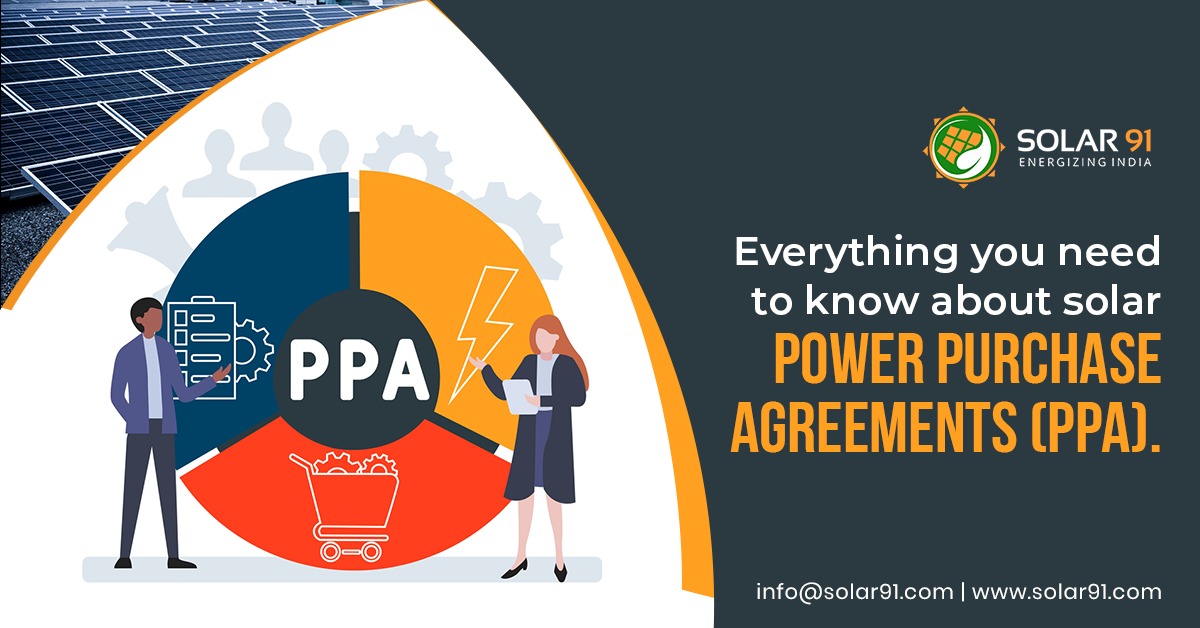Everything you need to know about Solar Power Purchase Agreements (PPA)
If you value environmental stewardship, you’ve definitely considered installing solar panels to power your facility. The first thing you’ll notice is that this can be a considerably more involved proposition than you anticipated. Of course, you’ll need to choose the solar panels that are best for you and appropriate to your location— but the difficulties don’t end there.
You’ll need to hire a contractor who has experience in installing these panels, as well as navigate any local ordinances or requirements regarding the use of solar panels, as well as work through the complicated tax documents and forms required to receive tax incentives for installing a clean energy system.Solar power purchase agreements (PPAs) provide a feasible alternative to all of this labour, providing all of the benefits of owning a solar energy system without the same hassles and red tape.
What do you mean by Solar Power Purchase Agreement (PPA)?
Here is how a Solar Power Purchase Agreement works: A developer will pay for the construction of a solar energy system on your land, doing all of the legwork and verifying all the legal work and formalities for you. The developer then resells the energy to you at a set price. This way, you get the benefits of a lower electric bill and a reduced carbon footprint without having to make a large upfront investment that will cost you a lot of money and time.
Benefits of Solar Power Purchase Agreement (PPA)?
No or low upfront capital costs
The developer handles the upfront capital costs of sizing, acquiring, and installing the solar PV system. The host customer can embrace solar with no upfront expenditure and start saving money as soon as the system is operational.
Reduced energy cost
Solar PPAs, which are structured in one of two ways, give a set, predictable cost of electricity for the duration of the agreement. The price the consumer pays climbs at a predefined rate under the fixed escalator plan, often between 2% and 5%. This is frequently less than the predicted increase in utility prices. The fixed price plan, on the other hand, keeps a constant price during the PPA’s life, saving the consumer more money as utility rates rise.
Limited Risk
Risk is limited because the developer is in charge of system performance and operational risk.
Better Leverage and tax credits
Developers are often in a better position to use available tax credits to lower system costs. Municipal hosts and other public entities with no taxable income, for example, would not be able to take advantage of the tax benefits.
Substantial Raise in Property value
A solar PV system has been found to boost residential property values. Because of the long-term nature of these agreements, PPAs can be transferred with the property, allowing customers to invest in their houses at little or no expense.
Things You Should Know about Solar Power Purchase Agreement (PPA)
Little or no Capital Cost
The expense of planning, installing, and maintaining the solar system will not be borne by the consumer. It is the developer’s responsibility to offer all of the following during the life of the contract. Because there is no upfront investment, the host customer benefits from cheaper electricity prices and saves money that would have been required to purchase the solar system.
Possible increase in property value
A solar system will typically increase the value of a residential property. SPPA agreements, which typically have a length of 10 to 25 years, are frequently transferred with the sale of a property from one owner to the other. The suitable SPPA agreement will ensure long-term electricity prices that are lower than the actual market price, increasing the property’s value.
Market Adoption and Policy
SPPAs streamline the entire installation process and give a way to bypass the first large capital outlay associated with PV system installation.
Low Energy Bills
The SPPAs always have a fixed rate of payment for the term of the contract. Depending on the customer’s preferences, the agreement is typically constructed in two ways:
– The rate paid at the start of the contract does not change until the end of the contract in the fixed plan. Throughout the length of the agreement, the host customer is charged a fixed monthly amount.
– The alternative structure is based on a progressive rate. In this case, the bill climbs at a predetermined rate, usually between 2% and 5%, which is still less than the predicted increase in utility electricity prices.
Conclusion
A Solar Power Purchase Agreement is a financial agreement in which a third-party developer arranges for the design, permitting, financing, and installation of a solar energy system on a customer’s property at a reduced cost.
To learn more about Solar Power Agreement contact your near solar contractors.

